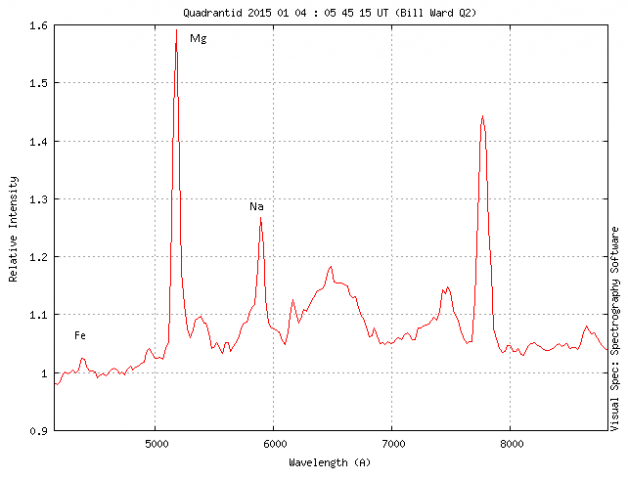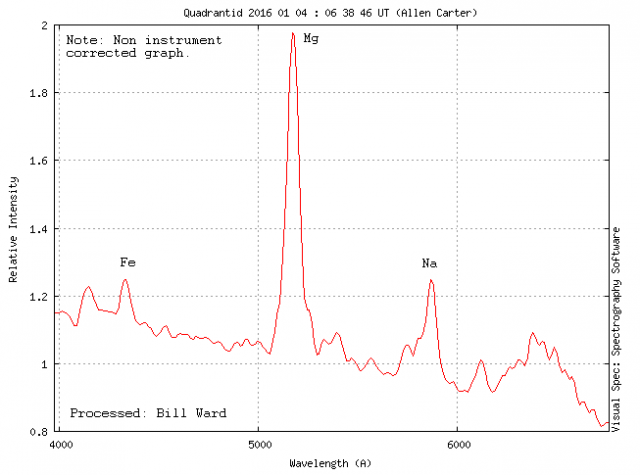- This topic has 5 replies, 2 voices, and was last updated 9 years, 11 months ago by
 Bill Ward.
Bill Ward.
-
AuthorPosts
-
4 January 2016 at 4:27 pm #573518
 Bill WardParticipant
Bill WardParticipantHi,
After the excitement of last years Quadrantids, this year has been a disappointment!
I was really hoping to get more spectra to confirm my observations from 2015. I know there are now several other stations taking spectra so maybe someone else will have been lucky and got some results.
On the radio front, the shower showed it’s usual sharp peak with good counts through 0300-0700UT. Maximum was 0500-0600UT (155 counts/hour) for my location.
The picture is from around the peak this morning.
Lots of “pings”
Maybe next year… 😉
cheers,
Bill.
Attachments:
4 January 2016 at 5:41 pm #577207 Nick JamesParticipant
Nick JamesParticipantAmazingly it was clear here last night. On two cameras I collected 240 events. These were classified as 153 Quadrantids, 45 December alpha Draconids and 22 sporadics. All my captures are here. The brightest event of the night was this one at 031153. UA2 classified it as a Southern Taurid but I doubt if it really is. We’ll find out for sure when we have dual station data.
It will be interesting to correlate these with radio data.
Nick.
4 January 2016 at 6:50 pm #577208 Bill WardParticipant
Bill WardParticipantHi Nick,
Sounds great.
Other obsevers not that many miles away also had good conditions, very frustrating!
ALL weather is local as they say… 😉
cheers,
Bill.
6 January 2016 at 12:01 am #577215 Nick JamesParticipant
Nick JamesParticipantBill,
These are nice results on the Quads and they show that we now have a really powerful tool to do good science on these streams. There is an interesting recent paper on the proposed parent (asteroid 196256) by Kasuga and Jewitt here and here. I think the jury is still out on whether this really is the parent so any physical data we can gather on the meteoroid stream will be very useful.
Nick.
6 January 2016 at 4:41 pm #577218 Bill WardParticipant
Bill WardParticipantHi,
Thanks for the paper info. It’s an interesting read. Jenniskens makes reference to the same object in his book Meteor Showers and their parent bodies. He ends the section on the Quadrantids with the same sentiment, that it’s not quite a done deal yet.
Yes, I’m very pleased that after a little evangelising 😉 others have joined in the new pursuit of “Survey Video Meteor Spectroscopy”. It’s taken me 7 years to refine the system but I think its now gone from novelty to utility and that’s great. It is indeed a powerful tool and who knows what it will turn up in the coming years. The regular showers are interesting enough BUT its the sporadic population where I believe the real surprises will be.
I think I mentioned “family groups” elsewhere and I’m pretty sure I’ve started to see this. Initally three spectra caught my eye. These were all from different observers over several years. That has now gone up to six sporadics with very similar properties so theres something going on!
cheers,
Bill.
6 January 2016 at 4:42 pm #577214 Bill WardParticipant
Bill WardParticipantHi,
Things just got interesting again…!
One of the other NEMETODE observers, Allen Carter, now runs a system identical to mine (A Watec 910/12mm f0.8/600g/mm) and managed to catch a couple of spectra from the peak of the Quadrantids. Allen kindly sent me his images to analyse and the results are great.
Last year seemed to indicate a very distinctive spectrum for the QUA meteoroids. My spectra were quite conclusive on the composition but being a single station there was the possiblity of mis-identifying a weaker Dec Alpha Draconid stream as a QUA.
There seems little doubt now that the QUA’s are “sodium deficient” cf magnesium. What this means has to do with the parent body and it’s possible origin and orbit. That’s now a whole new story to be explored…
Here is one of my spectra from last year.

and here is Allens from this year (basically yesterday, at date of posting!)

I’ve added the main lines for comparison. Mine caught a little more in the near IR so has a longer wavelength span but it is clear the blue/green regions are almost identical. Importantly both having a large Mg peak.
There may be wavelength resolution limits which has some impact on line ID with video work but I think this is an excellent example of the utility now to be had from meteor spectroscopy on conducting comparative analysis (just like my STA examples). The key issue is that unlike imaging, spectroscopic observations can be directly compared station to station essentially without ambiguity.
RESULT!
Thanks to Allen Carter (and other Nemetode stations) for his support in providing his observations to me.
Now all we need are some spectra of the Dec Alpha Draconids to be able to compare stream to stream!
cheers,
Bill.
-
AuthorPosts
- You must be logged in to reply to this topic.
